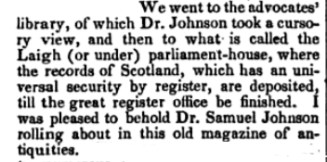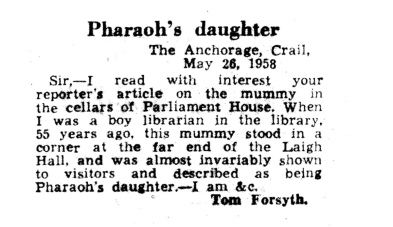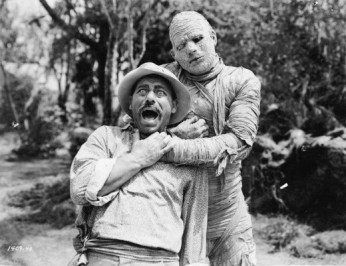Once upon a time and long, long ago (660-330 BC, to be slightly more precise) a man lived, died and was mummified in ‘late period’ Egypt. Sadly that is all we currently know about this person, but death was only the beginning of his story…
The Earl of Morton
In the year 1748 James Douglas, 14th Earl of Morton, presented an Egyptian mummy to the Faculty of Advocates.[1] It is not clear exactly why the Earl chose to bestow this gift but it was duly accepted and “set up in their Library”.[2]
The Advocates Library was always more than just a repository for books. From the earliest times Members were collecting artworks and curios as well as books and manuscripts. The Library became something of a museum and guests were often shown round the exhibits.

The life of Samuel Johnson: including A journal of a tour to the Hebrides, Volume 1, James Boswell, 1832, p. 333
The English writer Samuel Johnson was once given a tour of the Library by his friend and biographer James Boswell, advocate. Although the mummy would have been in residence by that time, Boswell fails to mention him.
However, in his Handbook to the Parliament House (1884) James Balfour Paul, Faculty Treasurer, makes a passing, yet poetic, reference to:
An old mummy…[who] slumbers in a dark corner as calmly as if it were in the tombs at Memphis. (p.78)
Pharaoh’s Daughter
During its time in the ‘dark corners’ the Faculty Mummy suffered more indignities than the average Egyptian gentleman is used to. From having his wrappings partially removed by some curious person, to being used for bayonet practice by the Members’ Rifle Corps (according to Faculty lore)! Worst of all, it seems to be during this period that the Mummy came to be known as “Pharaoh’s Daughter”. On the plus side, he did have a standing invitation to the Faculty Annual Dinner where, we are told (by the lore again), songs were sung and toasts were drunk to the health of the Pharaoh’s Daughter.
The Mummy nobody wants
Eventually though it was decided the Faculty didn’t really need an Egyptian Mummy anymore. According to the Records he was offered on loan to the Royal Scottish Museum in 1906. However, after examination the poor Mummy was “found to be in a condition unsuitable for exhibition” [3]
The Faculty tried again, in 1954, to rid itself of the unwanted artefact. Cyril Aldred the “Royal Scottish Museum authority on Egyptian things” examined the Mummy and returned a brief report. Although it is generally quite scathing you can’t help but enjoy the tone of his summary:
If [the Faculty Mummy] is never seen again by mortal eye, I can assure you that neither science, scholarship nor aesthetics will suffer in consequence [4]
In his accompanying letter W Beattie, National Librarian, is rather understating things with the comment “the enclosed report…is, I’m afraid, disappointing for you”.
Attempts were made to locate other museums interested in taking him – none were found. ‘For sale’ adverts were placed in the papers – there were no takers. When the Faculty at last tried to just throw the Mummy away, even the Council cleansing department refused to uplift on the grounds it was human remains – but remains which could not be buried without a death certificate!
In May 1958 The Scotsman published a piece entitled “Riddle of the mummy nobody wants”. This amusing article detailed the almost farcical trouble the Faculty was experiencing in its efforts to dispose of the artefact:
What is it which has no birth or death certificate, cannot be sold or given away, cannot be burned because it is a human body, yet cannot be buried for lack of a certificate of death? The answer lies in the cellars of Parliament House, Edinburgh, in a dilapidated wooden coffin – a 3000-year-old Egyptian mummy, property of the Faculty of Advocates [5]
Following publication the story was picked up by newspapers around the world. The Faculty began receiving letters from such places as Holland, Germany, Belgium, France, Switzerland and Australia – as well as from closer to home. While many of these correspondents were offering the Mummy a new home, some just wrote tendering unhelpful advice on the predicament.
One of the correspondents, according to the Clerk of Faculty, had “a much more respectable offer than the others.” [6] Dr AT Sandison, a lecturer and radiologist at Glasgow University’s Pathology Department, was keen to take the mummy off the Faculty’s hands. He had “been working on the histology of such remains” and would be willing to collect.[6] On the 18th June 1958 the Faculty accepted Dr Sandison’s offer and in August the Mummy left the Advocates Library for the last time. This is where we lost track of him…
Until, that is, I decided to do some research of my own.
Rediscovery?
Starting with the Mummy’s last known address, I contacted Glasgow University. Learning that, on Dr Sandison’s death in 1982, his collection of antiquities passed into the care of The Burrell Collection in Glasgow, I contacted a Senior Curator there. He was able to confirm receipt of ‘The Sandison collection’ in 1982. He was aware of two mummies that were being kept in storage, neither with proper provenance… nor a head.
He described the artefacts to me as follows:
-
- one was female; her wrappings in good condition, with decoration – like painted jewellery – round her neck and wrists
- the other was male; in such bad condition he was little more than a skeleton…
I was able to say, with a modicum of certainty, that the tatty auld bag of bones was likely to be the former Faculty Mummy.
Unfortunately the storage facility was at that time inaccessible so I was unable to visit the Mummy myself. However, I did pass on some information – gleaned from the museum report of 1954 – about the condition of the Faculty Mummy’s wrappings and coffin at that time. This may help The Burrell Collection make a definitive identification once they again have access. It may also be possible to identify which of six mummified heads may belong with ours!
So, there you have it. The sad history of the Faculty Mummy: used as a political tool; shuffled from one dusty corner to another; prodded with all manner of pointed instruments; and now, headless and in storage. We should perhaps be thankful he was not the sort of mummy who comes with a curse…
[1] ‘The affair of Lord Morton’s Mummy’, Iain Gordon Brown, Egypt through the eyes of travellers, Starkey and Kholy (eds), 2002, p.95
[2] Minute Book of the Faculty of Advocates, volume 2, 1713-1750, The Stair Society, 1980, page 237-238
[3] Faculty Records, 14 June 1906
[4] Letter from Cyril Aldred to William Beattie, 13 July 1954 with covering letter from Mr Beattie to the Vice-Dean of Faculty [Faculty of Advocates ‘Mummy file’]
[5] The Scotsman, 26th of May 1958, page 8
[6] Letter from AT Sandison to the Secretary, Faculty of Advocates, 27 May 1958 and a note (on a compliment slip) from RDI, 28 May 1958 [Faculty of Advocates ‘Mummy file’]
*EDIT – October 2015*
A version of this story was originally published in 1958 by The Scotsman newspaper. This post was inspired by research I carried out in 2008 for an internal exhibition at the Faculty of Advocates. The exhibition was based around the unique and wonderful ‘Mummy file’, a collection of letters and newspaper clippings held in the Faculty’s archives. These items were gathered following the huge (and hilarious) interest generated by the Scotman article – a copy of which was included in the file. The collection of letters is a treasure but, since they are physical items (and don’t belong to me), I couldn’t post them here. I could however recount the wonderful story behind them.
I am always scrupulous about citing my sources. However, when I first wrote this post (originally entitled The sad history of the Library Mummy) it was a only a short and entirely anonymous reminder of an enjoyable research project. I always prefer to keep posts anonymous when possible. References to the FoA were only added recently, after I received interest from that quarter.
At that time, I omitted to cite a work by Mr Iain Gordon Brown since I didn’t quote from it in the post. However, it was a handy guide to the background story and a resource I used alongside the ‘Mummy file’ and the Minute Book of the Faculty of Advocates. I also investigated methods of mummification via Google! I apologise to Iain Gordon Brown for hurting his feelings. It was not intentional. I sought only to write a nice wee story.
In order to avoid any further unpleasantness, here is a complete list of citations as they appeared in the full text of my exhibition, as well as names of the lovely people who helped with my enquiries.
References & resources:
- Scots Magazine, July 1748
- Minute Book of the Faculty of Advocates, volume 2, 1713-1750, The Stair Society, 1980, page 222
- ‘The affair of Lord Morton’s Mummy’ by Iain Gordon Brown, Egypt through the eyes of travellers, edited by Paul Starkey and Nadia Kholy, 2002
- Dictionary of National Biography, Oxford University Press, 1997
- Walks in Edinburgh, Robert Chambers, 1825, p. 108-109
- Handbook to the Parliament House, James Balfour Paul (1884), p.78-79
- Minute Book of the Faculty of Advocates, volume 2, 1713-1750, The Stair Society, 1980, page 237-238
- Letter from Cyril Aldred, [Royal Scottish Museum] to William Beattie, 13 July 1954 with covering letter from Mr Beattie to the Vice-Dean of Faculty [Faculty of Advocates ‘Mummy file’]
- ‘Riddle of the mummy nobody wants’, The Scotsman, 26th of May 1958, page 8
- Letter from AH Keizer to “Members of Parliament”, 19 June 1958 [Faculty of Advocates ‘Mummy file’]
- Letter (with envelope) from Uta Schweiger, 3 July 1958 [Faculty of Advocates ‘Mummy file’] – translation from ‘The affair of Lord Morton’s Mummy’ by Iain Gordon Brown, Egypt through the eyes of travellers, edited by Paul Starkey and Nadia Kholy, 2002
- Letter from AT Sandison to the Secretary, Faculty of Advocates, 27 May 1958 and a note (on a compliment slip) from RDI, 28 May 1958 [Faculty of Advocates ‘Mummy file’]
- Letter from Ian S Macmillan, 25 May 1958 [Faculty of Advocates ‘Mummy file’]
- Letter from AH Barrowman to the Secretary, Faculty of Advocates, 17 June 1958 [Faculty of Advocates ‘Mummy file’]
- ‘Mummy’, a song from The Best of Cameron Miller: an anthology of his songs and other writings, compiled by Sheriff N.E.D. Thomson CBE
- http://www.mummytombs.com/egypt/methods.htm – page no longer available
- http://www.schoolshistory.org.uk/mummification.htm
- Newspaper clipping [Australian?] – date and publication unknown
- Newspaper clipping [France-soir?] date unknown
Helpful people:
- David C Brown, Senior Library Assistant (Bibliographic dept.), Advocates Library
- Professor Barry Gusterson, Section of Pathology and Gene Regulation, University of Glasgow
- Simon R Eccles, Senior Curator (The Burrell Collection) Ancient Civilisations, Glasgow
Extra special thanks are due to Simon Eccles for his kind assistance.




Pingback: Where did he run off to? | Adventures in History and Archaeology
Reblogged this on A Very Fine Library and commented:
An EDIT of a fun post from May 2015.
LikeLike
Pingback: And the winner is… The sad history of the Faculty Mummy | A Very Fine Library
Pingback: Scots Law doing Doors Open Day, 2016 | SLLG Blog
Pingback: The (slightly updated) history of the Faculty Mummy | A Very Fine Library